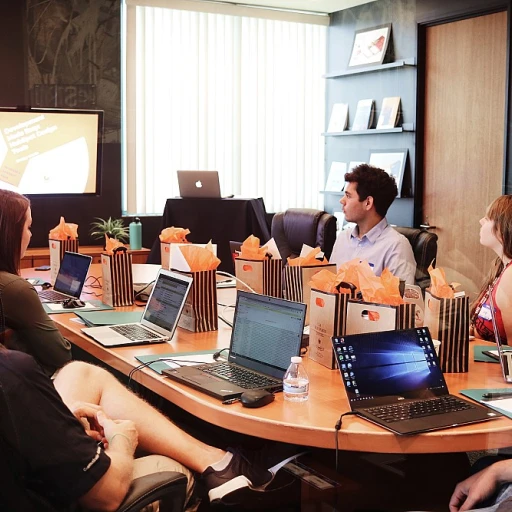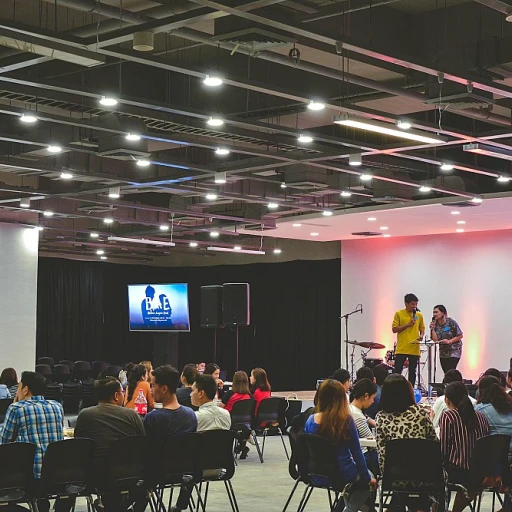
Understanding Employee Engagement
The Essence of Active Participation in the Workplace
Employee engagement is a fundamental aspect of any successful business strategy, offering a transformative impact on the workplace experience. At its core, it refers to the emotional and psychological commitment that an employee has towards their work and the organization. This involves fostering a work environment where employees feel valued, motivated, and connected, which ultimately leads to enhanced productivity and employee satisfaction.
With the rise of digital tools and hybrid work models, companies have been afforded new opportunities to reshape the workplace ecosystem. An engaged employee likely feels a sense of belonging, driven by a supportive company culture and effective workplace strategy. These elements come together to form a positive workplace where communication, recognition, and work-life harmony thrive.
Business leaders and experience managers play a critical role in enhancing employee engagement by understanding and adapting to the needs of their teams. Implementing a comprehensive strategy that embraces the digital landscape can further support this goal. A great workplace utilizes digital signage, modern workplace tools, and open channels of employee communication to bridge physical and digital divides, nurturing a cohesive work environment.
Furthermore, understanding the link between employee engagement and incentive systems is crucial. Organizations benefit from adopting a well-structured compensation plan that aligns with employee aspirations and organizational goals. This approach not only bolsters engagement but also propels the company towards a more promising future workplace.
The Role of Leadership in Engagement
The Power of Leaders in Shaping Engagement
In today’s dynamic work environment, leadership plays a pivotal role in influencing employee engagement. Leaders are not just figureheads within an organization; they are the guiding force that can significantly enhance the workplace experience, fostering a positive atmosphere where employees feel valued and motivated.
A leader's ability to shape employee commitment starts with clear and consistent communication. By maintaining an open-door policy and actively listening to employees, leaders create a safe environment for the exchange of ideas and feedback, which boosts employee satisfaction. This approach is crucial in both traditional and hybrid work models.
Creating Trust and Recognition
Strong leadership hinges on trust. Employees need to trust that their leaders will support them, especially during transitions to digital or hybrid work frameworks. This trust fosters a solid foundation for creating a positive workplace. Furthermore, recognizing and celebrating achievements is an essential practice that leaders should embrace. This not only acknowledges individual contributions but also reinforces a culture of recognition.
In fact, leaders who prioritize recognition, whether through formal awards or informal kudos, are more likely to see increased levels of employee engagement. For those seeking inspiration, consider exploring inspiring quotes for boosting colleague engagement which can serve as motivation for both leaders and their teams.
Leveraging Technology for Engagement
As business landscapes evolve, the integration of technology becomes essential in strengthening employee communication. Tools like digital signage, enhanced air quality monitors, and other technological advancements contribute to a future workplace that prioritizes employee comfort and engagement.
Leaders must be proactive in driving these technological innovations, ensuring they align with the company's values and workplace strategy. This results in a tighter company culture and a great workplace that adapts to organizational changes while keeping engagement levels high.
Creating a Culture of Recognition
Fostering a Culture of Acknowledgment
Creating a culture where employee accomplishments are recognized and celebrated is pivotal in enhancing the overall workplace experience. Recognition fuels motivation and makes employees feel valued, fostering a positive workplace environment.
Recognition doesn't always have to be grandiose or tied to significant achievements. Simple actions like a verbal acknowledgment or a shoutout in a meeting can make a substantial difference in how employees feel about their contributions to the team. With the rise of digital tools and hybrid work models, companies can leverage platforms for digital signage or even internal social networks to publicly celebrate achievements, exemplifying a vibrant workplace culture that inspires others.
For organizations striving to improve workplace engagement, embedding recognition into the workplace strategy is crucial. Employees who feel appreciated are often more committed, fostering a culture of loyalty and positivity. Experience managers play a critical role in this process, ensuring that recognitional efforts are consistent and inclusive. This leads to higher employee satisfaction as the organization acknowledges the hard work and dedication of its staff.
Moreover, it's important to tailor recognition methods to the individual. Some may appreciate a public acknowledgment, while others may value a personal note. Understanding these preferences can amplify the impact of recognition, making sure it resonates with each employee and enhances the work environment.
In our connected world, where technology plays a role in bridging gaps across hybrid work settings, cultivating an appreciation-rich culture can significantly boost employee engagement. This positions the company as a great workplace, committed to nurturing its human capital and investing in its people.
The Impact of Communication on Engagement
The Power of Transparent and Two-Way Communication
In today's dynamic work environment, effective communication is one of the cornerstones of employee engagement. As organizations navigate the intricacies of hybrid work models, the importance of fostering clear and consistent communication becomes even more pronounced. Open channels of communication are essential for creating a positive workplace where employees feel valued and understood. For example, employees need confidence in their workplace strategies, which often hinge on how well leaders can communicate plans and expectations. To enhance the workplace experience, organizations must adopt modern tools and technologies. Digital communication platforms not only bridge geographical gaps but also ensure that teams, whether remote or in-office, remain connected. This aligns with the rise of hybrid work, where maintaining a seamless flow of information is critical. Additionally, incorporating tools like digital signage can improve workplace communication by providing instant updates on company initiatives, goals, or even air quality improvements that affect employee well-being. By integrating these technologies, companies create an environment where information is easily accessible, promoting a culture of transparency and trust. Effective communication also involves active listening. Employees should feel that their voices are heard and acted upon. Experience managers play a vital role here, facilitating feedback and ensuring it leads to meaningful changes. An organization that values dialogue cultivates a sense of belonging and purpose among its staff, reinforcing a strong company culture. Moreover, meaningful communication impacts employee satisfaction profoundly. When employees are informed and engaged with the company's mission and values, they are more likely to be productive and committed, ultimately bolstering employee engagement. In conclusion, as companies aim to build a great workplace, they must recognize that clear, effective communication is an ongoing process that requires continuous improvement and adaptation to modern business needs. This not only improves the work life of employees but also enhances the overall workplace experience.Work-Life Balance and Its Influence on Engagement
Perceptions of Balance in Hybrid Work Environments
The push for a more balanced work-life arrangement has intensified with the rise of hybrid work models. Employees crave flexibility, and when organizations provide it, they often see enhanced engagement levels. By accommodating hybrid arrangements, companies can effectively address the diverse needs of their workforce, leading to a more positive workplace atmosphere.The Role of Technology in Facilitating Work-Life Balance
In the digital workplace, technology plays a pivotal role in shaping the employee experience. With tools that facilitate seamless communication and task management, employees can maintain productivity without being tied to the office. Digital signage and communication platforms bring transparency and clarity, supporting an environment where employees feel empowered to manage their own schedules.Strategies for Promoting a Healthier Work Environment
Creating a healthy work environment is essential for promoting employee engagement. Experience managers need to focus on implementing strategies that address air quality, ergonomic designs, and other factors that contribute to the overall work environment. When employees feel their health and safety are prioritized, it positively affects their connection with the company culture.Maintaining Engagement Through Employee Satisfaction
Employee satisfaction stands as a core pillar of effective engagement strategies. It's imperative that organizations develop a workplace strategy that cultivates satisfaction by offering benefits that support work-life balance. By prioritizing wellness programs and flexible work conditions, both business outcomes and employee happiness can flourish. In turn, this investment in employee satisfaction fosters a great workplace that enhances overall engagement.Measuring and Improving Engagement
Evaluating Engagement Levels in Your Workplace
In order to measure and improve employee engagement effectively, companies must tailor their approach based on the specific needs and dynamics of their work environment. Employee satisfaction can be quantified using various methods, each designed to capture different dimensions of the employee experience and workplace culture.
- Surveys and Feedback Tools: Surveys are common tools companies utilize to gather insights into an employee's perception of the workplace. They can gauge satisfaction with leadership, recognition, and work-life balance. Tools like digital surveys or feedback platforms allow for anonymity, encouraging honest responses which can highlight areas for improvement.
- Employee Pulse Surveys: These are shorter, more frequent surveys that help track changes in employee engagement over time. They can be particularly effective in hybrid work environments or during times of organizational change.
- Performance Metrics: Key performance indicators (KPIs) should reflect employee engagement levels and can include turnover rates, productivity levels, and absenteeism. Consistently analyzing these metrics can reveal trends that impact company culture and the workplace experience.
Implementing Strategies to Boost Engagement
Once the data has been collected, it’s essential to implement actionable strategies aimed at improving engagement. An effective workplace strategy involves continuous improvement and adaptation to new findings.
- Enhance Communication: Clear, open communication is vital for fostering a positive workplace. Utilizing digital tools to facilitate better employee communication can bridge gaps, especially in hybrid work setups.
- Foster a Positive Work Culture: Organizations should strive to create an environment where employees feel valued and recognized. Implementing a culture of recognition goes a long way in improving the workplace environment.
- Leverage Technology: New technologies can support the measurement and enhancement of employee engagement. Digital signage and other innovative tools can disseminate important company messages while creating an engaging office atmosphere.
Regularly reviewing and adjusting these strategies ensures they meet the evolving needs of employees and the organization. As the nature of work continues to change, understanding and improving employee engagement remains a cornerstone of a successful business.













